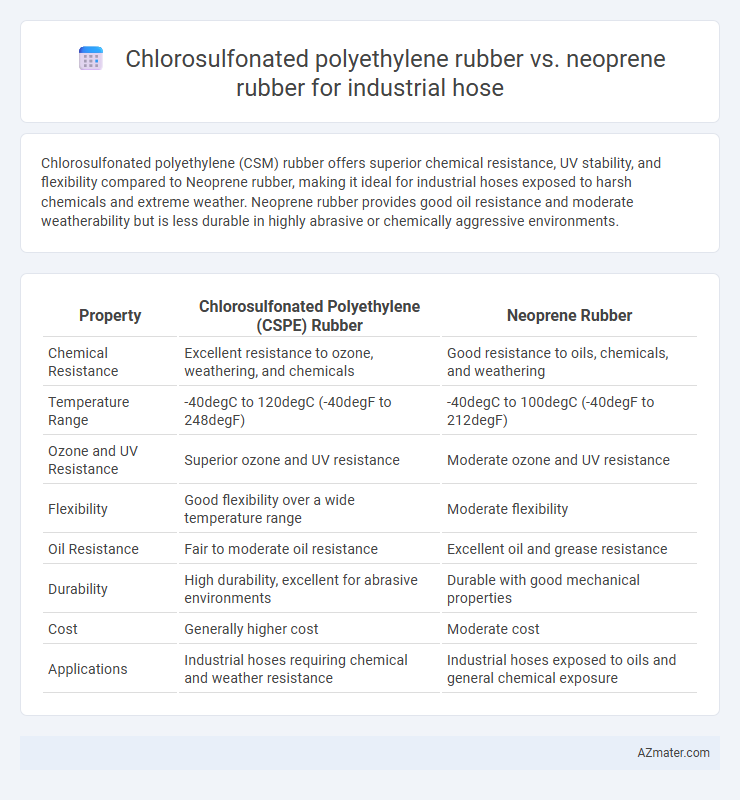Chlorosulfonated polyethylene (CSM) rubber offers superior chemical resistance, UV stability, and flexibility compared to Neoprene rubber, making it ideal for industrial hoses exposed to harsh chemicals and extreme weather. Neoprene rubber provides good oil resistance and moderate weatherability but is less durable in highly abrasive or chemically aggressive environments.
Table of Comparison
| Property | Chlorosulfonated Polyethylene (CSPE) Rubber | Neoprene Rubber |
|---|---|---|
| Chemical Resistance | Excellent resistance to ozone, weathering, and chemicals | Good resistance to oils, chemicals, and weathering |
| Temperature Range | -40degC to 120degC (-40degF to 248degF) | -40degC to 100degC (-40degF to 212degF) |
| Ozone and UV Resistance | Superior ozone and UV resistance | Moderate ozone and UV resistance |
| Flexibility | Good flexibility over a wide temperature range | Moderate flexibility |
| Oil Resistance | Fair to moderate oil resistance | Excellent oil and grease resistance |
| Durability | High durability, excellent for abrasive environments | Durable with good mechanical properties |
| Cost | Generally higher cost | Moderate cost |
| Applications | Industrial hoses requiring chemical and weather resistance | Industrial hoses exposed to oils and general chemical exposure |
Introduction to Industrial Hose Materials
Chlorosulfonated polyethylene (CSM) rubber offers superior resistance to chemicals, ozone, and weathering, making it ideal for industrial hoses exposed to harsh environments and aggressive substances. Neoprene rubber provides excellent balance of flexibility, oil resistance, and durability, suited for applications requiring moderate chemical exposure and mechanical stress. Choosing between CSM and Neoprene depends on specific industrial hose requirements such as temperature tolerance, chemical compatibility, and exposure conditions.
Overview of Chlorosulfonated Polyethylene Rubber
Chlorosulfonated polyethylene (CSM) rubber, commonly known as Hypalon, exhibits exceptional resistance to chemicals, weathering, and UV radiation, making it a preferred choice for industrial hoses subjected to harsh environments. Its unique molecular structure provides superior tensile strength and flexibility compared to neoprene, enhancing durability in applications involving abrasive materials and extreme temperatures. CSM's excellent resistance to ozone, oxidation, and solvents surpasses neoprene's performance, ensuring longer hose life and reduced maintenance in demanding industrial settings.
Key Properties of Neoprene Rubber
Neoprene rubber exhibits excellent chemical stability, resistance to oils, solvents, and weathering, making it ideal for industrial hose applications requiring durability under harsh conditions. Its superior flexibility and tensile strength ensure reliable performance in dynamic environments, while its resistance to ozone and UV exposure enhances hose longevity. Compared to chlorosulfonated polyethylene rubber, neoprene offers better resistance to aging and a broader temperature range, enhancing overall hose durability and functionality.
Chemical Resistance Comparison
Chlorosulfonated polyethylene (CSPE) rubber offers superior resistance to acids, alkalis, and oxidation, making it highly suitable for industrial hoses exposed to harsh chemical environments. Neoprene rubber exhibits good resistance to oils, solvents, and moderate chemical exposure but tends to degrade faster when in contact with strong acids and alkaline substances. For applications requiring long-term durability against aggressive chemicals, CSPE rubber provides enhanced chemical stability compared to neoprene.
Mechanical Performance Differences
Chlorosulfonated polyethylene (CSM) rubber exhibits superior resistance to abrasion, ozone, and weathering compared to neoprene, making it ideal for industrial hoses exposed to harsh environments. Neoprene rubber provides better oil and chemical resistance but typically shows lower tensile strength and elongation at break than CSM, impacting durability under mechanical stress. The enhanced mechanical performance of CSM, including higher tensile strength (up to 22 MPa) and elongation (over 400%), supports its use in demanding industrial hose applications requiring flexibility and toughness.
Weather and Ozone Resistance
Chlorosulfonated polyethylene (CSM) rubber exhibits superior weather and ozone resistance compared to Neoprene rubber, maintaining flexibility and physical properties under prolonged exposure to UV radiation and harsh environmental conditions. Industrial hoses made with CSM rubber demonstrate excellent durability in outdoor applications, resisting cracking and degradation caused by ozone and oxidative agents. Neoprene rubber, while moderately resistant, tends to lose elasticity faster and may develop surface cracks under severe weathering and ozone exposure, reducing the hose lifespan in demanding industrial environments.
Temperature Tolerance and Flexibility
Chlorosulfonated polyethylene (CSM) rubber exhibits superior temperature tolerance, maintaining flexibility and physical properties within a broad range from -40degC to 135degC, making it ideal for industrial hoses exposed to fluctuating thermal conditions. Neoprene rubber, while offering good chemical resistance and moderate flexibility, typically operates effectively between -40degC and 120degC, slightly limiting its use in higher temperature environments compared to CSM. In terms of flexibility, CSM provides enhanced elasticity and resilience, particularly in cold temperatures, ensuring hose durability and performance under dynamic industrial applications.
Cost-Effectiveness for Industrial Applications
Chlorosulfonated polyethylene (CSM) rubber offers superior chemical resistance and durability compared to Neoprene, making it a cost-effective choice for industrial hoses exposed to harsh environments such as acids, alkalis, and solvents. Although Neoprene typically has a lower initial price, its shorter lifespan and lower resistance to UV and ozone often result in higher replacement and maintenance costs over time. Evaluating total lifecycle expenses, CSM rubber hoses provide better value for demanding industrial applications requiring enhanced performance and longevity.
Common Industrial Uses: CSM vs Neoprene
Chlorosulfonated polyethylene (CSM) rubber is widely used in industrial hoses requiring excellent resistance to weathering, ozone, and chemicals, making it ideal for outdoor and chemical processing applications. Neoprene rubber, known for its balanced oil resistance and good flexibility, is commonly employed in air and water hoses, refrigeration, and general-purpose industrial uses. Both materials offer strong durability, but CSM excels in harsh environmental exposure, while Neoprene provides superior versatility in moderate chemical and temperature conditions.
Choosing the Right Rubber for Your Industrial Hose Needs
Chlorosulfonated polyethylene (CSPE) rubber offers superior chemical resistance and UV stability, making it ideal for industrial hoses exposed to harsh outdoor environments and aggressive chemicals. Neoprene rubber provides excellent flexibility, oil resistance, and moderate weathering properties, suitable for hoses in petroleum-based applications and moderate outdoor exposure. Selecting the right rubber depends on factors such as chemical compatibility, temperature range, and environmental conditions to ensure optimal hose performance and longevity.

Infographic: Chlorosulfonated polyethylene rubber vs Neoprene rubber for Industrial hose
 azmater.com
azmater.com